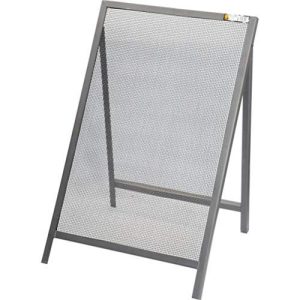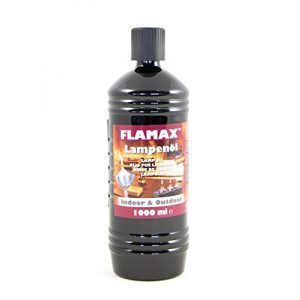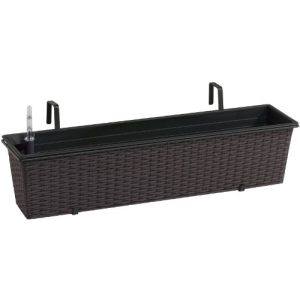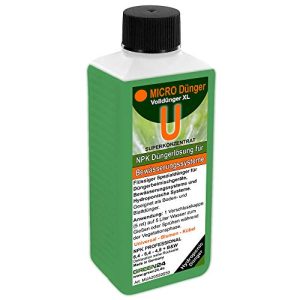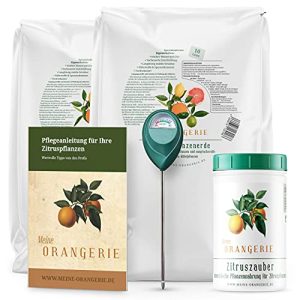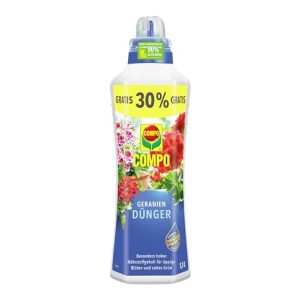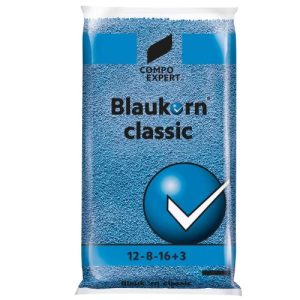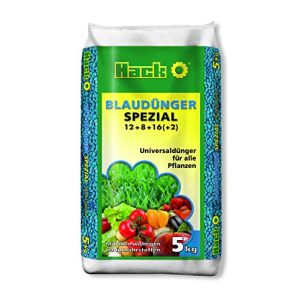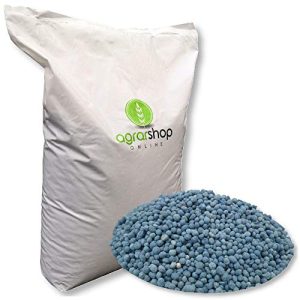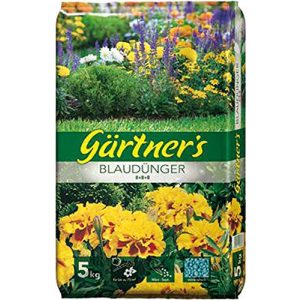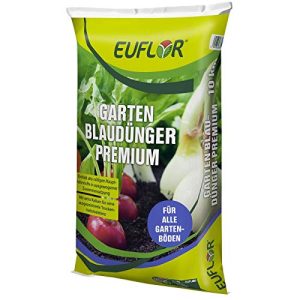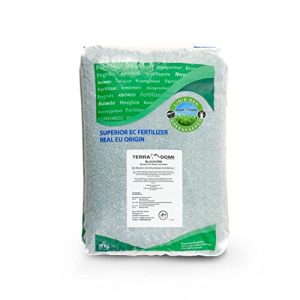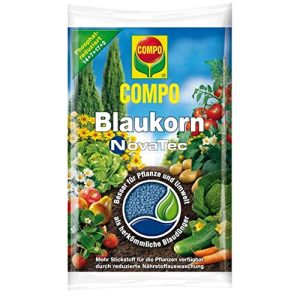Find the best blue grain: Your guide from our test & comparison
Test winner in focus: Compare, evaluate and choose the perfect blue grain
- Blue grain is an efficient type of fertilizer that optimally contributes to supporting the health and growth of plants. Their nutrient composition contains all the important nutrients, which makes them particularly valuable in garden care.
- The special thing about blue grain is its balanced nutrient ratio, which means plants are optimally supplied. It is an ideal source of nutrients, especially for vegetable plants, bedding plants and fruit trees. It promotes healthy plant growth and prevents deficiency symptoms.
- Indispensable in garden maintenance, blue grain has a firm place in the market. With its extensive variety of nutrients, it provides valuable support for a variety of plants and contributes to a healthy, blooming garden.
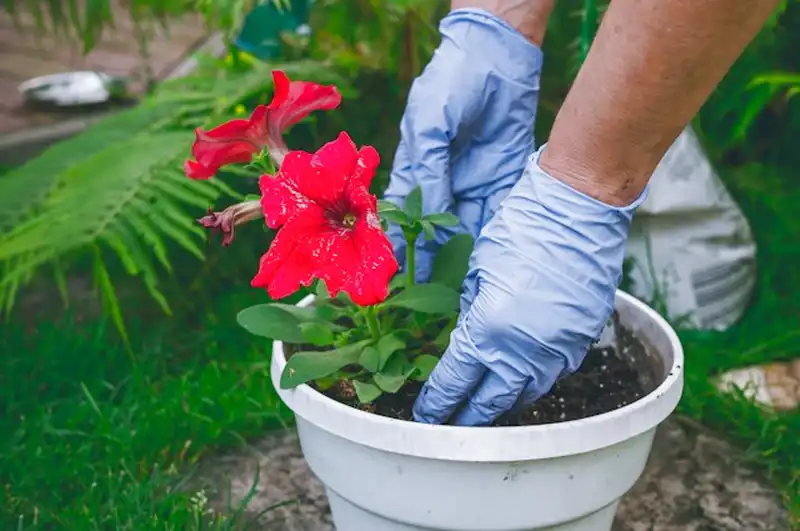
Buying recommendation: Sensible use of Blaukorn for healthy and magnificent plants!
As an avid gardener and botany enthusiast, I have enjoyed the popularity of blue grain always observed. This Blue grain fertilizer has established itself as an indispensable component in garden care. Its popularity comes from the efficient supply of the plants with vital nutrients. But what does it mean? Blue grain cheap online buy on yourself and why do followers swear by it Blaukorn for organic on this complex fertilizer?
To answer these questions, I don't just examine them Blaukorn prices and find out what the best blue grain fertilizer but also critically examines how and where one can Buy blue grain fertilizer cheaply can. It's about more than just advertising promises; it's about the effectiveness and benefits in the ecological cycle of the garden.
Purchase overview: Your guide to Blaukorn
- blue grain provides essential nutrients such as nitrogen, phosphorus and potassium.
- The application should be careful and environmentally conscious in order to avoid risks to the ecosystem.
- Choosing the right blue grain product depends on the type of plant and soil conditions.
- Careful dosing is crucial to prevent overfertilization and possible damage to plants.
- There are organic alternatives too blue grainthat support sustainable garden design.
- Not every plant tolerates it blue grain, therefore expert advice is advisable in individual cases.
Amazon: Blaukorn – The proven choice for effective plant nutrition
Introduction: What is blue corn and its importance in the garden?

It is a complete mineral fertilizer that is available in granulated form and ensures a slow and even release of nutrients.
The Blue grain meaning in horticulture is of great importance for my plants. Originally named for its characteristic blue color and the combination of essential nutrients, blue grain is considered essential mineral fertilizers in plant care. The primary ones Blue grain nutrients like Blue grain nitrogen, Blue grain phosphorus and Blue grain with potassium are essential for the various growth processes of plants - from leaf development to root strengthening to flower formation.
The Blue grain application is characterized by its rapid effectiveness and allows me to effectively supply my plants with nutrients. However, care is required when it comes to dosage and when to use it. It is of the utmost importance to avoid possible negative effects on the environment and plants due to excessive use, which is why I always make sure to follow the manufacturer's instructions meticulously.
Blaukorn serves in mine Garden as an important building block for a healthy plant cycle and is a solution for targeted nutrient supply. Its balanced composition ensures the development of strong plants and helps to meet special needs in vegetative growth.
The right choice: Which blue grain is best for your plants?
The Blue grain selection often presents gardeners with challenges because not every Blaukorn product is suitable for every type of plant. The Best blue grain fertilizer for your garden inhabitants depends on their individual needs and the conditions of your soil. Roses, for example, require a specially tailored nutrient ratio that varies from that for fruit.
Did you know that Blaukorn for rose specific requirements met to ensure optimal flower formation?
In the Buy blue grain cheaply You should also make sure that one of high quality Composition is present. Especially when growing fruit and perennials, it is important to choose a product that supports the plants in their growth without the risk of over-fertilization.
- Blue grain for fruit: Choose a product with a balanced potassium content to promote fruiting.
- Blue grain for perennials: Look for increased phosphorus content, which supports root formation and flower development.
Take the time to compare the different products and get comprehensive information Buy blue grain cheaply to be able to. The focus should not be on price, but on suitability for your plant species and the soil conditions in your garden.
Tip:
Also look at the long-term effects of the various Blaukorn products to guarantee your plants a continuous supply.
- Check the pH value of the soil: blue grain is not suitable for all plants.
- Consider your plants' specific nutritional needs.
- Compare the nutrient ratios and compositions of Blaukorn products.
- Choose a product that not only benefits your plants but also maintains ecological balance.
Amazon Blaukorn: High-quality nutrients for strong growth and lush flowers
- 3 x 2,5 liters COMPO Blaukorn NovaTec liquid universal fertilizer, NPK 8+8+6
Blaukorn in use: dosage and time of application
Using blue seed as fertilizer in my garden is a critical step in ensuring my plants get exactly what they need. Blue grain dosage and Blaukorn application time require precise attention as both have a significant impact on plant health and the environment. A common mistake that many garden lovers make is the uncritical and generous use of fertilizers without taking the specific needs of the beds into account.
About the topic When to use blue grain To address this, it is advisable to consider the different phases of plant growth. In general, it is recommended to use blue grain in spring, just before the main growth phase begins. The precise timing helps the plants use the nutrients provided efficiently for their growth. It is important to understand that application after July is often not recommended as plants are preparing to go dormant and absorb fewer nutrients during this time.
- For Blue grain for beds is regular fertilization from March to the beginning August advisable, especially for heavy-feeding plants such as tomatoes or peppers.
- When it comes to dosage, the principle applies: less is often more. Excessively high concentrations of blue grain can damage not only the plants themselves, but also the ecosystem in which they live.
- A soil analysis can help to assess the nutrient supply to the beds and prevent over- or under-dosing.
Another consideration is the individual sensitivity of different plant varieties. While some plants tolerate more fertilization, others - such as hydrangeas - can even be damaged. In such cases, switching to milder, organic fertilizers such as bark a better choice.
The optimal one Blue grain dosage depends not only on the plant species, but also on its development stage and the individual soil conditions. Careful planning and advice from experts can be crucial for successful and environmentally friendly use of blue grain.
Finally, it should be emphasized that Blaukorn is a powerful Tools in horticulture. Proper handling not only guarantees lush plant growth and productive harvests, but also helps protect our valuable environment for future generations.
Areas of application for Blaukorn: From lawns to vegetables
Blue grain fertilizer is an all-rounder when it comes to supplying plants with essential nutrients. My experience in garden care has shown me that the diverse applications of blue grain fertilizers can help to significantly improve plant health and support their development.
Blaukorn lawn fertilizer – green lawn made easy
A lush green and a dense turf are everyone's flagship Garden. blue grain lawn fertilizer plays a crucial role in this. The question often arises: “Are blue grain fertilizers good for lawns?” The answer is: yes, because the balanced nutrient composition supports the growth of the lawn and contributes to one weed-free and strong green space. However, it is important to follow the application instructions carefully in order to avoid over-fertilization and the resulting damage.
Blaukorn for gorgeous tomatoes and other fruit
Whether for tomatoes in the vegetable patch or to strengthen fruit trees and grapes – Blaukorn leads to impressive results. For lush growth and a rich harvest, targeted fertilization with blue grain is essential, with the addition of nitrogen in particular ensuring the formation of strong fruit heads.
Fertilize potted plants and balcony plants with blue grain
pot plants and Balconies place special demands on the nutrient supply. Through the limited Earth In pots and boxes they rely on regular fertilization. Blue grain fertilizer is ideal for this as it provides the nutrients necessary for abundant flowering and healthy growth. However, the application should be adapted to the needs of individual plant species.
Vegetable patch and herb patch: use blue grain correctly
Both in the Vegetable patch as well as in the herb patch A balanced nutrient supply is of great importance. The question, “How do I use blue grain for my vegetable patch?”, is quickly answered: A dosage of blue grain tailored to the respective vegetable can significantly increase the growth and vitality of the plants. Blue grain can also offer benefits for herbs. Blue grain for herbs contributes to strong growth and intensive aroma development. It is essential to ensure that: “Is blue grain good for herbs?” is not answered with too much concentration, but with a measured effort.
Get your Blaukorn now on Amazon and give your plants the right nutrient kick
- High-quality fertilizer: RUEMAR blue fertilizer is a mineral NPK fertilizer for all garden...
- Universal fertilizer for all plants: use the fertilizer to fertilize fruit and vegetables, berry plants,...
- NPK Fertilizer 8+8+8: Add important minerals to your plants. 8% nitrogen for high...
Roses and blue corn: tips for blooming splendor
The application of Blue grain fertilizer has a positive effect on rose care. If you Blue corn for roses Use it to provide your flowers with the essential nutrients they need to grow vigorously and bloom profusely. Find out how you Use blue grain fertilizer and can optimally promote the growth of your roses.
The benefits of blue corn for roses
The question, is blue grain good for roses, can be clearly answered in the affirmative. The rich nutrient mixture in Blaukorn supports the plants in different growth phases. Great attention is paid to the effect of nitrogen-based nutrients, which help the roses to develop their full bloom and provide the plants with the strength for new growth. How does blue grain affect flowers?? Quite simply: it stimulates the formation of flower systems and ensures improved flower quality and number.
Correct use of blue grain fertilizer on roses
The Blaukorn application on roses should be targeted. Distribute it Fertilize evenly around the root area of the roses and work it gently into the top layer of soil. Make sure that remontant varieties that bloom several times a year are cut back slightly after the first flowering period and carefully fertilized a second time with blue grain. This should be done in good time to avoid temperatures that are too cold, which could damage the plants.
Blaukorn: Environmental compatibility and alternatives
As a passionate gardener, I focus on sustainability and want to keep the impact of my activity on the environment as low as possible. The debate about the Blaukorn environmental sustainability has also reached me, and I think it is important not to ignore the potential risks to groundwater and wildlife. That's why I'm working intensively on alternatives to Blaukorn.
Sustainable fertilization methods compared to blue grain
When comparing Blaukorn vs Horn shavings or other organic fertilizers such as coffee grounds or compost, it turns out that the sustainable variants are not only suitable for plant nutrition, but also improve the soil structure and actively promote soil life - an advantage that blue grain cannot offer with its chemical composition. For me as a gardener who strives for environmentally conscious fertilization, these methods offer an effective alternative without harming the environment.
Organic alternatives to blue grain
I asked myself: Can I use blue corn in the pot and keep a clear conscience? My research showed that it was organic blue grain and similar products that do not require the use of harmful chemicals. These organic alternatives, such as composted plant residues or diluted compost tea, are ideal for fertilizing in pots and promote healthy plant growth without having to worry about environmental sustainability. It is particularly important for organic gardening Blaukorn for organic-Certification or to use completely natural fertilizers in order to meet the strict standards of organic farming.
Amazon Blaukorn: Optimal care for healthy plants and productive harvests
- Provides your plants with all important main nutrients
- For rapid growth
- For strong roots
Advantages and Disadvantages of Blaukorn: A Critical View
As a long-time gardener, I am sure Blue grain pros and cons consciously. blue grain is a widely used fertilizer that provides a rapid supply of essential nutrients such as Blue grain nitrogen, Blue grain with potassium and Blue grain phosphorus offers. This leads to accelerated plant growth and increased harvest. What contains blue grain? exactly to deliver these results? The answer lies in its rich composition of the above-mentioned nutrients, which are fundamental for plant development.
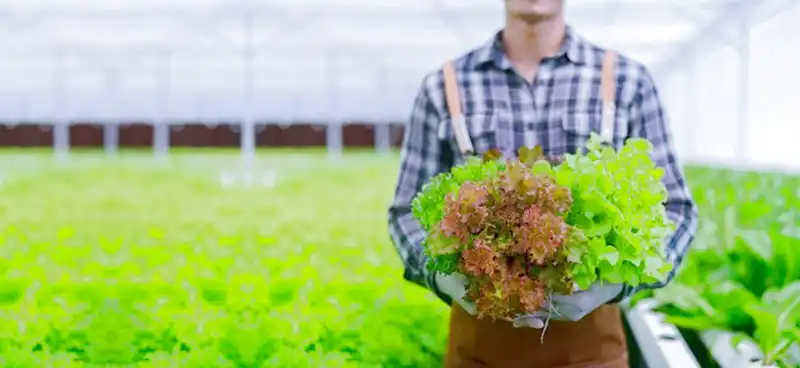
Blue grain is mainly used for fertilizing vegetable plants, ornamental plants and lawns.
But one Blaukorn critical view also reveals the potential risks: the danger of over-fertilization and the possible impact on groundwater. If used excessively, nutrient-rich runoff can enter water sources and disrupt ecological balance and cause health problems. For this reason, responsible use of this fertilizer is essential.
“Sustainable gardening is based on the right balance between providing plants with nutrients and protecting our environment.”
- Efficient and targeted nutrient supply
- Fast response from the Plants on fertilizer
- Improving yield and plant health
- Overfertilization can lead to excess nutrients and plant damage
- Risk of groundwater contamination and possible health hazards
- Requirement of expert application to avoid negative environmental influences
In conclusion, I proceed carefully to take advantage of the benefits of blue grain to use it and at the same time minimize its disadvantages. The responsibility I have as a gardener encompasses the entire environment and not just my garden.
Blaukorn, bestseller for the garden soil
Every plant needs nutrients to thrive ground withdrawn. If there are only a few nutrients in the soil, fertilization must be carried out. A classic fertilizer is undoubtedly blue grain, which is offered by many manufacturers as a universal fertilizer. Because blue grain is inexpensive, it is one of the most popular universal fertilizers. Since blue grain contains all the important basic nutrients, it can be used for almost all crops. However, not all blue grain is the same. The universal fertilizer is available in different compositions. Our Blaukorn comparison shows what is important when buying.
What is blue grain?
Blue grain or blue fertilizer is a mineral artificial fertilizer. It is particularly rich in nutrients and shows an immediate effect. The nutrients are absorbed very quickly. However, the composition is different, as you can easily see in our table. Its advantage is that it is easy to use, but it is not used in professional agriculture because one is bound to the composition. Single fertilizers are preferred here because they can be used better on the soil conditions and the needs of the respective plants.
Blue grain rating according to the most important nutrients
Blue grain is also known as NPK fertilizer because it contains the most important nutrients such as N = nitrogen, P = phosphorus and K = potassium. Magnesium and sulfur are added to many NPK fertilizers. Since these five substances are required by all plants for growth, the blue grain can be used universally.
NPK fertilizer composition
NPK 12-8-16: for nitrogen-rich soils that are low in potash and phosphate
NPK 15-3-20: for phosphate-rich soils that are low in potassium
NPK 14-7-17: for soils low in phosphate and potash
NPK 21-5-10: for low-nitrogen soils
The pros and cons of blue grain
Blue grain fertilizer can be used flexibly. It quickly improves the nutrient content in the soil. At the same time, it is suitable for a wide variety of plants. Care must be taken when using it, because blue grain is poisonous to dogs and cats, and can also cause symptoms of poisoning in humans.
Blue Grain Advantages / Disadvantages
Benefits
- Quickly available nutrients
- Suitable for all kinds of plants, lawns, fruit trees and shrubs
- also for indoor plants
- as granules or liquid
Disadvantages
- danger of over-fertilization
- Can cause symptoms of poisoning
Blue Grain Granules vs Blue Grain Liquid
The classic and blue grain bestseller is the blue granulate, which is offered in the form of small balls. You can spread it quickly and work it into the soil. If the blue grain is used for the lawn, it should either be done just before it rains or it needs to be watered in. The other variant is the Blaukorn liquid fertilizer, which is offered as a concentrate for dilution with water.
Our blue grain purchase advice
In order to buy the right blue seed, you should first deal with the nutrient requirements of the plants to be fertilized. Bamboo, for example, is sensitive to too many nutrients, and it is also not suitable for hydrangeas. Therefore, always first look at the information printed on the back of the packaging for which plants the blue grain is suitable.
Blue grain granules or liquid?
This depends on what you want to fertilize with the blue grain. This is for dense planting liquid fertilizer better because it can penetrate the soil more quickly; the granules would remain on the leaves and harm the plant without watering. For hedges or bushes and before planting, granules are more suitable because they can be incorporated into the soil.
Which container sizes of granules?
Blue grain granules are usually sold in boxes or plastic bags of 5 kg, 10 kg, 20 kg or 50 kg. Based on experience, 5 kg of granules are sufficient for an area of up to 100 m².
Which container sizes for liquid Blaukorn?
Liquid blue grain is offered as a concentrate. You get it in Bottles from 250 ml up to 2,5 liters in the canister. Also make sure you have a dosing aid so that you don't have to do the measuring based on feel.
Which blue grain is inexpensive?
To find out, you should look at the price pros Calculate kilos. This is often even stated on the Internet. So you can at least make a Blaukorn price comparison for granules. When it comes to liquid products, the mixing ratio must also be taken into account. Our Blaukorn purchase recommendation: Buy larger containers, this reduces the price. If there are any leftovers, they can still be used next year if they are well sealed.
Is there a Blaukorn test report from Stiftung Warentest?
Unfortunately, we have not yet found a blue grain test at Stiftung Warentest. Fertilizers have not yet been put to the test. You will definitely find what you are looking for in the many garden forums that exist on the Internet or you can read the reports in the customer reviews.
Conclusion: When is Blaukorn worthwhile and when should you avoid it?
Blaukorn, a proven NPK fertilizer, has proven itself many times in garden care. Particularly demanding plant species, which require an intensive supply of nutrients, thrive with it. Blaukorn is a good choice, especially in phases of strong growth spurts in which quickly available nutrients are important. Whether you want Blaukorn for the Use sowing or to make your flowering plants one Flower splendor There is no general answer and should always be decided carefully.
When it comes to purchasing, so be it cheap blue grain online easy to find, but you should also pay attention to the quality. Depending on the requirements and situation, it is important to decide When to use blue grain makes sense and when alternatives should be used. Sensitive plant species and those that prefer specific soil conditions may suffer from the application of blue grain.
- The acidic soils Avoid loving plants
- The Environmental concerns resort to alternatives
- For a balanced fertilization consider organic products
environmental and the search for sustainable practices are becoming increasingly important. It is advisable that Sustainability of fertilization to question it and, if there are concerns, to switch to organic, more environmentally friendly options. For everyone who values practical and efficient gardening, it should be said: blue grain is just one of many ways to achieve one healthy plant growth; the decision is ultimately yours.
Blue grain is a powerful tool in any gardener's hand, but like any tool, it should be used responsibly and thoughtfully to get the most out of your garden while caring for our environment.

